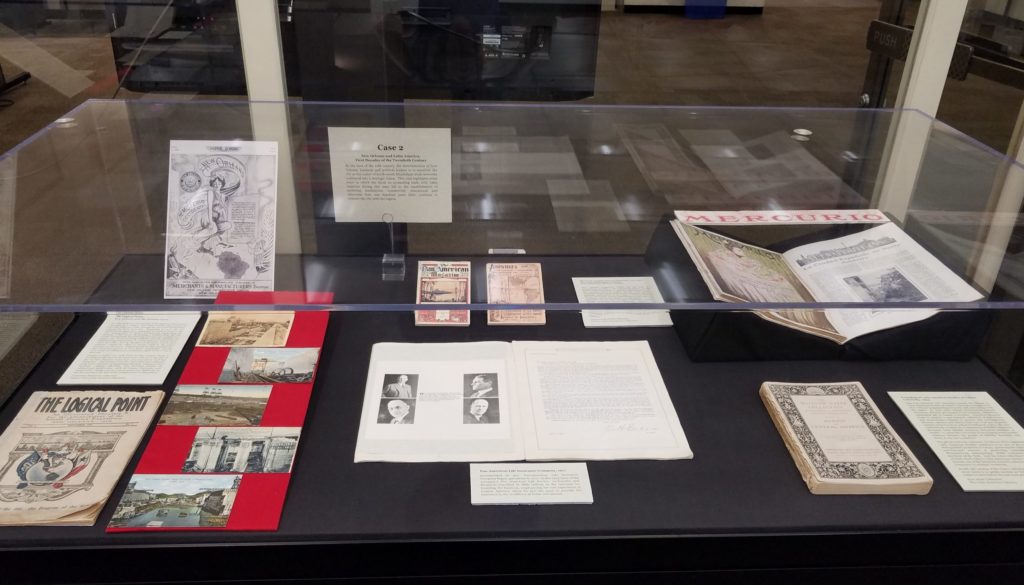By the turn of the 19th century, the determination of New Orleans’ business and political leaders to re-establish the city as the center of north-south Mississippi trade networks coalesced into a strategic vision. This case highlights some ways in which the focus on promoting trade with Latin America during this time led to the establishment of enduring institutions, commercial, educational and otherwise that, one hundred years later, continue to connect the city with the region.

Case 2, a physical exhibit at the Latin American Library.
Contents
The texts and images highlight the materials exhibited in Case 2.
The Logical Point: New Orleans and the Panama Canal
For New Orleans, the opening of the Panama Canal (1914) emerged as a unique and long-awaited opportunity to increase shipping traffic through the port and substantially expand its trade networks. Beginning in 1910, the city launched an aggressive campaign to position itself as the sole “logical place” to hold a World’s Fair celebrating the opening of the Canal. By hosting a World’s Fair, the city would demonstrate its economic prowess and viability as a major port. It would bring publicity and also highlight its longstanding connections to Latin America, among many other benefits. Led by the city’s Progressive Union, New Orleans’ spared no effort to situate itself as the prime location for the event. Unfortunately for the Crescent City, San Francisco proved to be a fierce competitor, and the U.S. Congress ultimately awarded the rights to the event to that city.
Displayed in the lower left corner of the case, an early issue of The Logical Point, a monthly publication to promote New Orleans as the site of the World’s Panama Canal Fair, over and above rival San Francisco. The articles tout the city’s historical affinities with Latin America, geographical location, enhanced port facilities, cultural offerings, and included articles on educational institutions, such as Tulane University and much more. Images from various issues are displayed on the five panels to the left of the exhibit poster in this gallery.
Louisiana Research Collection
Tulane University Special Collections
Postcards Showing the Panama Canal Under Construction, c. 1906-1913
Image Archive
The Latin American Library
Mercurio, revista mensual ilustrada, 1911-1927
Mercurio Publishing Company
New Orleans Progressive Union
New Orleans’ Progressive Union did not limit its promotional activities to the commercial sphere. It also funded cultural projects to promote international trade. The monthly Mercurio (shown in the upper right corner of the case) was one such venture. Regarded as the most prestigious of New Orleans’ Spanish-language publications at the time, it boasted Spanish literary luminaries such as José Echegaray and Miguel de Unamuno among its regular correspondents. A truly impressive list of other frequent contributors included Spanish dramatist Jacinto Benavente, Mexican poet Amado Nervo, Peruvian poet José Santos Chocano, and many more. The publication also featured advertisements by local retail, financial, travel, real estate and other commercial establishments as well as educational and cultural institutions targeted to well-to-do Latin Americans, enticing them to travel to and invest in New Orleans.
Louisiana Research Collection
Tulane University Special Collections
Pan-American Life Insurance Company, 1911
Incorporated in 1911, Pan-American Life Insurance Company began operations in 1912. At case center, is a 1923 issue of the company’s Pan American Life Review, in which co-founder and President Crawford H. Ellis reflects on the rationale for founding the business, emphasizing his own experience in Central America which inspired him to resolve the issue of providing life insurance to the workforce at home and abroad.
Founding of Latin American Studies at Tulane University, 1924
Like Pan-American Life Insurance Group, the origins of Latin American Studies at Tulane University emerged from New Orleans’ longstanding economic and cultural ties with the region. In 1924, New Orleans businessman Samuel Zemurray, director of Cuyamel Fruit Company, awarded a substantial gift to Tulane University. Zemurray donated funds to acquire a vast research collection of rare books and manuscripts relating to ancient and contemporary Mexican cultures and history that was to be put to public auction in New York by collector William E. Gates. He also endowed the creation of a Department of Middle American Research (now Middle American Research Institute or MARI) “to assist the University in developing more cordial relations between the people of [Middle America] and those of our own [country].”
The gift proved to be visionary. On the eve of its centennial, Latin American Studies continues to be one of its most distinguished programs at Tulane, garnering the university international renown. A pioneering institution in Mesoamerican anthropology, MARI continues at the forefront of the field. And the Gates collection is the core around which today’s Latin American Library was built to become one of the foremost research collections of its kind, a resource to scholars worldwide.
Appearing in the bottom right of the case is the catalog of the Gates collection. The collection never made it to public auction as Tulane purchased the entire lot days before the sale took place.
Rare Book Collection
The Latin American Library